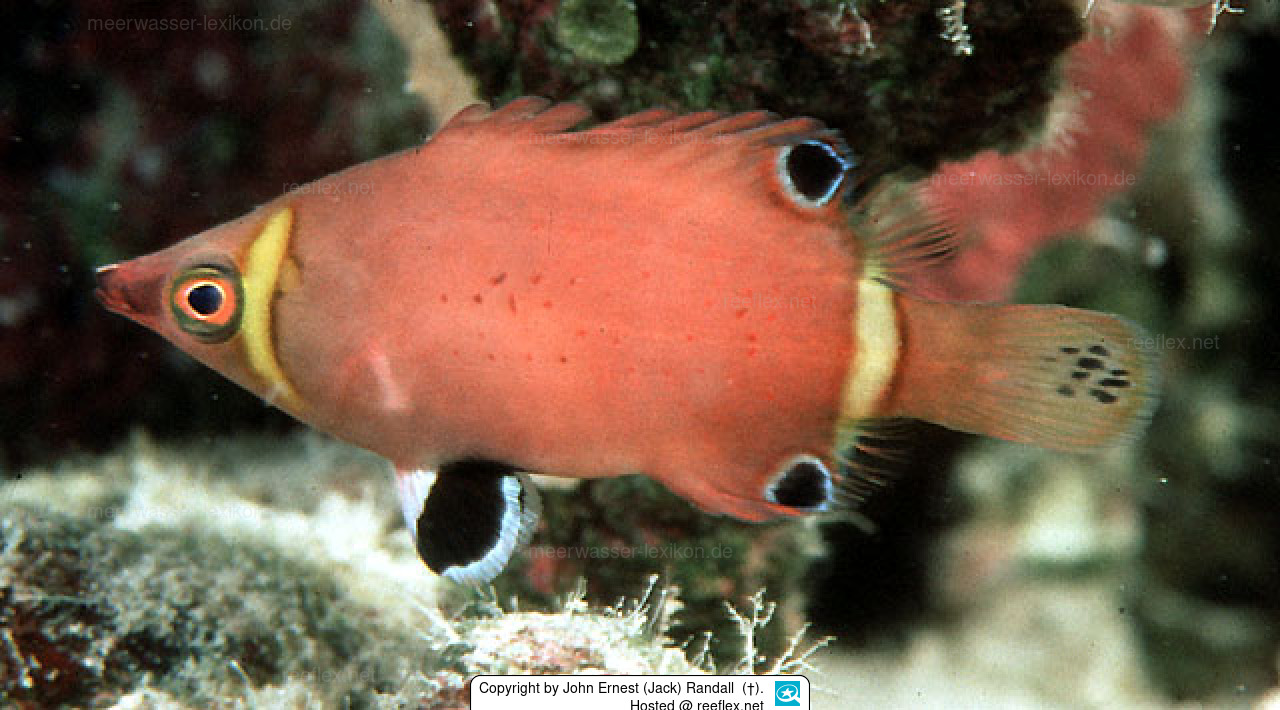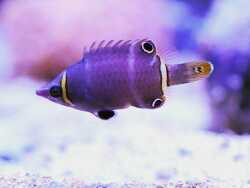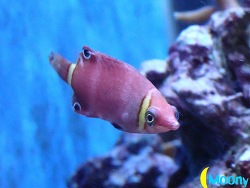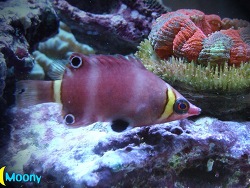Info
Wetmorella nigropinnata, Seale, 1901
Wetmorella is a genus of wrasse (Labridae). Wetmorella species live very hidden in the back, dark sections of caves in outer reefs, occasionally in lagoons, and feed on small vertebrates.
Wetmorella nigropinnata is a small gray to reddish brown wrasse with a yellow stripe behind the eye, a second yellow stripe on the caudal root, dark eye spots on the dorsal and anal fins, and a large dark spot on the ventral fins.
Juveniles are mottled brown with two additional light bars on the body.
Wetmorella nigropinnata is a small gray to reddish-brown wrasse with a yellow bar on the head behind the eye, a second yellow bar on the caudal peduncle, dark ocelli on the soft dorsal and anal fins, and a large dark spot on the pelvic fins.
Juveniles are mottled brown with two additional light stripes on the body.
Wetmorella nigropinnata is distinguished from Wetmorella albofasciata and Wetmorella tanakai by two broad, slightly oblique, pale stripes on the body of juveniles and subadults. In Wetmorella albofasciata, the two narrow pale stripes converge on the underside.
Synonymised names:
Cheilinus nigropinnatus Seale, 1901 · unaccepted
Wetmorella ocellata Schultz & Marshall, 1954 · unaccepted
Wetmorella philippina Fowler & Bean, 1928 · unaccepted
Wetmorella philippina bifasciata Schultz & Marshall, 1954 · unaccepted
Wetmorella phillipina Fowler & Bean, 1928 · unaccepted (misspelling)
Wetmorella triocellata Schultz & Marshall, 1954 · unaccepted
Jumping guard
A jumping guard prevents (nocturnal) fish from jumping out.
Wrasses, blennies, hawkfishs and gobies jump out of an unprotected tank in fright if their night rest is disturbed, unfortunately these jumpers are found dried up in the morning on carpets, glass edges or later behind the tank.
https://www.korallenriff.de/en/article/1925_5_Jump_Protection_Solutions_for_Fish_in_the_Aquarium__5_Net_Covers.html
A small night light also helps, as it provides the fish with a means of orientation in the dark!
Wetmorella is a genus of wrasse (Labridae). Wetmorella species live very hidden in the back, dark sections of caves in outer reefs, occasionally in lagoons, and feed on small vertebrates.
Wetmorella nigropinnata is a small gray to reddish brown wrasse with a yellow stripe behind the eye, a second yellow stripe on the caudal root, dark eye spots on the dorsal and anal fins, and a large dark spot on the ventral fins.
Juveniles are mottled brown with two additional light bars on the body.
Wetmorella nigropinnata is a small gray to reddish-brown wrasse with a yellow bar on the head behind the eye, a second yellow bar on the caudal peduncle, dark ocelli on the soft dorsal and anal fins, and a large dark spot on the pelvic fins.
Juveniles are mottled brown with two additional light stripes on the body.
Wetmorella nigropinnata is distinguished from Wetmorella albofasciata and Wetmorella tanakai by two broad, slightly oblique, pale stripes on the body of juveniles and subadults. In Wetmorella albofasciata, the two narrow pale stripes converge on the underside.
Synonymised names:
Cheilinus nigropinnatus Seale, 1901 · unaccepted
Wetmorella ocellata Schultz & Marshall, 1954 · unaccepted
Wetmorella philippina Fowler & Bean, 1928 · unaccepted
Wetmorella philippina bifasciata Schultz & Marshall, 1954 · unaccepted
Wetmorella phillipina Fowler & Bean, 1928 · unaccepted (misspelling)
Wetmorella triocellata Schultz & Marshall, 1954 · unaccepted
Jumping guard
A jumping guard prevents (nocturnal) fish from jumping out.
Wrasses, blennies, hawkfishs and gobies jump out of an unprotected tank in fright if their night rest is disturbed, unfortunately these jumpers are found dried up in the morning on carpets, glass edges or later behind the tank.
https://www.korallenriff.de/en/article/1925_5_Jump_Protection_Solutions_for_Fish_in_the_Aquarium__5_Net_Covers.html
A small night light also helps, as it provides the fish with a means of orientation in the dark!







 Dr. John Ernest (Jack) Randall (†), Hawaii
Dr. John Ernest (Jack) Randall (†), Hawaii









